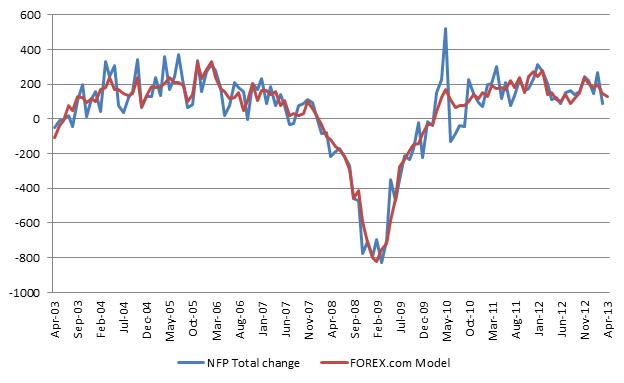On Friday, May 3, at 0830ET/1230GMT the US is forecasted to report a change in non-farm payrolls (NFP) of +145K (prior +88K; range +238/100K), a change in private payrolls of +160K (prior +95K; range +220K/+105K), and a steady unemployment rate of 7.6% (prior 7.6%; range 7.5/7.7%), according to Bloomberg market surveys. Our forecast model indicates an April headline NFP number of +131K jobs, which is slightly below consensus forecasts. We expect most of the job gains to come from private payrolls and are looking for the unemployment rate to hold steady at 7.6%.
With the Federal Reserve indicating its flexibility to adjust asset purchases as needed, markets are likely to be extra sensitive to economic data surprises. Furthermore, as the Fed’s dual mandate is focused on price stability and maximum employment, labor market developments are significant to the outlook for quantitative easing (QE). As outlined in the Federal Open Market Committee (FOMC) policy statement yesterday, “the Committee is prepared to increase or reduce the pace of its purchases to maintain appropriate policy accommodation as the outlook for the labor market or inflation changes.”
The circumstance that the pace of purchases can go in either direction places a good deal of emphasis on how the market interprets incoming data in relation to the expected monetary policy response. Significantly weaker than expected employment figures may be interpreted as an indication that the Fed will need to step up the pace of QE to reach its objectives, while data that shows improvement in labor markets may suggest the potential for a tapering of QE. Expected changes to the size and pace of QE tend to be inversely related to the performance of the USD. When markets begin to price in a reduction of QE, (which occurred recently when the Fed discussed tapering asset purchases) the USD benefits as fewer purchases means less dollars being printed by the central bank. On the other hand, an increase in the size or pace of QE would suggest an increase in the supply of USD which tends to have a negative impact on the dollar.
For now, we think that job growth will pick up from the previous month but remain weak overall. Job growth of 131k is well below the rolling 1-year and 2-year average job growth of about 159k and 180k respectively. Recent labor market data has been on the soft side with a decline in the ADP (Automatic Data Processing) payrolls to 118K in April from the prior 131K. The employment component of the ISM (Institute for Supply Management) manufacturing report fell to 50.2 from the previous 54.2 which indicates only narrow expansion. The ISM service sector report, which we tend to weigh more heavily in our forecast model since services represent a much larger portion of the US economy, will be released tomorrow after the BLS (Bureau of Labor Statistics) monthly employment report. Therefore it was not taken into consideration in our forecast for this month. Weekly initial jobless claims have improved notably which supports our view that job growth will increase from the prior month.
Exhibit 1: Our model forecasts headline NFP print of 131K for April
General Risk Warning for stocks, cryptocurrencies, ETP, FX & CFD Trading. Investment assets are leveraged products. Trading related to foreign exchange, commodities, financial indices, stocks, ETP, cryptocurrencies, and other underlying variables carry a high level of risk and can result in the loss of all of your investment. As such, variable investments may not be appropriate for all investors. You should not invest money that you cannot afford to lose. Before deciding to trade, you should become aware of all the risks associated with trading, and seek advice from an independent and suitably licensed financial advisor. Under no circumstances shall Witbrew LLC and associates have any liability to any person or entity for (a) any loss or damage in whole or part caused by, resulting from, or relating to any transactions related to investment trading or (b) any direct, indirect, special, consequential or incidental damages whatsoever.
Recommended Content
Editors’ Picks
EUR/USD fluctuates near 1.0700 after US data

EUR/USD stays in a consolidation phase at around 1.0700 in the American session on Wednesday. The data from the US showed a strong increase in Durable Goods Orders, supporting the USD and making it difficult for the pair to gain traction.
USD/JPY refreshes 34-year high, attacks 155.00 as intervention risks loom

USD/JPY is renewing a multi-decade high, closing in on 155.00. Traders turn cautious on heightened risks of Japan's FX intervention. Broad US Dollar rebound aids the upside in the major. US Durable Goods data are next on tap.
Gold stays in consolidation above $2,300

Gold finds it difficult to stage a rebound midweek following Monday's sharp decline but manages to hold above $2,300. The benchmark 10-year US Treasury bond yield stays in the green above 4.6% after US data, not allowing the pair to turn north.
Worldcoin looks set for comeback despite Nvidia’s 22% crash Premium

Worldcoin price is in a better position than last week's and shows signs of a potential comeback. This development occurs amid the sharp decline in the valuation of the popular GPU manufacturer Nvidia.
Three fundamentals for the week: US GDP, BoJ and the Fed's favorite inflation gauge stand out Premium

While it is hard to predict when geopolitical news erupts, the level of tension is lower – allowing for key data to have its say. This week's US figures are set to shape the Federal Reserve's decision next week – and the Bank of Japan may struggle to halt the Yen's deterioration.
